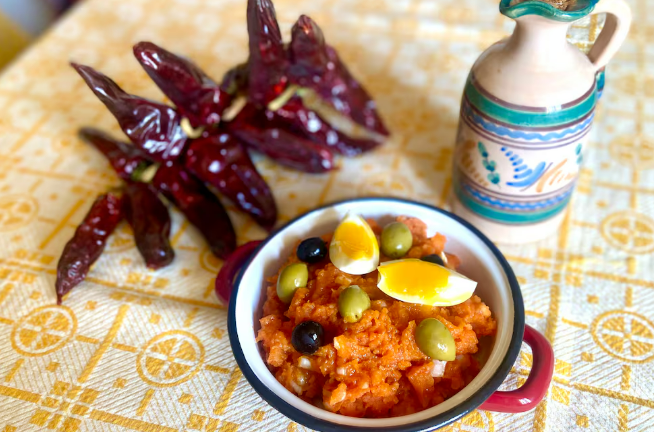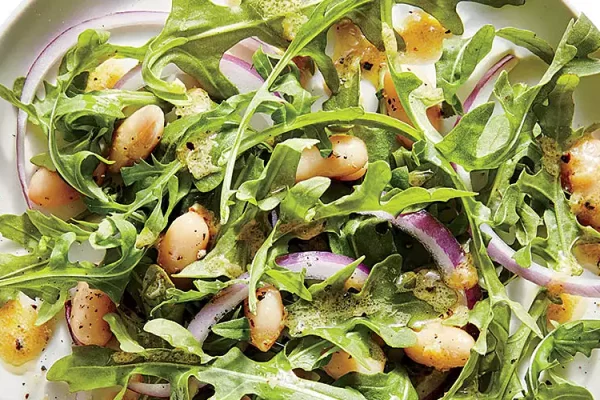Spain’s culinary tradition is full of dishes that can surprise—or confuse—even the most seasoned food lover. Many recipes share names but differ drastically depending on the region where they are served. “Gazpacho” in La Mancha bears little resemblance to Andalusia’s famous chilled soup, “ajoarriero” changes its character as you move across the country, and “pisto” varies from province to province. Another dish that belongs in this fascinating category of regional reinterpretation is rin ran.
Traveling across southern Spain offers a perfect illustration of how dramatically one dish can transform. In Extremadura, rin ran resembles a simple tomato salad. Head east to Murcia, and you’ll find a fish-based dish featuring ñora peppers, while potatoes are nowhere to be seen. By the time you reach Jaén, however, rin ran has become a hearty tapa starring mashed potatoes, smoky dried red peppers, and a touch of salted cod. To add to the confusion, Almería offers a dish called ajocolorao that’s almost identical to Jaén’s version. But here, in the rugged Sierra de Cazorla region of Jaén, rin ran shines in its most beloved form: a bright, paprika-hued potato dish perfect for summer.
What makes this Andalusian version so special? Three things: it’s as satisfying as a potato salad yet easier to prepare, its flavor combination of mashed potato, smoky pimiento choricero, and sweet onion is brilliantly balanced, and it’s served cold or at room temperature, making it an ideal tapa for warm weather. This humble recipe reflects the simplicity of Spanish rural cooking: a few quality ingredients, treated with care, create a dish that is as rustic as it is flavorful.
The foundation of rin ran lies in the use of pimientos choriceros—dried red peppers with a deep, smoky flavor. In traditional kitchens, the peppers are rehydrated and scraped to extract their vibrant pulp, but modern cooks can save time by using pre-prepared jars of pimiento choricero paste. Potatoes are boiled until tender, then lightly crushed rather than puréed, giving the dish its rustic texture. Sweet onion is soaked in water and vinegar to soften its bite and add a refreshing acidity, balancing the starchiness of the potatoes. A small amount of salted cod is flaked into the mix, lending subtle saltiness without overpowering the other flavors. Finally, everything is bound together with a generous drizzle of golden Spanish olive oil.
The preparation is straightforward, even for beginner cooks. First, the potatoes and peppers are simmered until tender. Meanwhile, onions soak in vinegar water, and a simple mortar-and-pestle mixture of garlic, cumin, and pepper pulp is prepared. The potatoes are peeled and roughly mashed, then combined with the pepper mixture, onion, and cod. A little cooking water can be added if the mixture feels too dense. The result is a creamy yet chunky base, tinted a beautiful orange from the peppers and olive oil.
The finishing touches are what make rin ran such an inviting tapa. Hard-boiled eggs, cooked for just seven minutes to keep their yolks slightly creamy, are cut into quarters and arranged on top. A scattering of briny olives and a final drizzle of extra-virgin olive oil complete the dish. The presentation is rustic, and although the traditional aceitera (oil cruet) is optional, it adds a charming, authentic touch when placed on the table.
This dish embodies the culinary spirit of Andalusia: thrifty, flavorful, and deeply connected to the land. The Sierra de Cazorla, part of Spain’s largest protected natural park, is famous not only for its breathtaking landscapes but also for its olive oil production, which plays a starring role in this recipe. Historically, rin ran was a peasant dish, made with simple pantry staples like potatoes, dried peppers, and salted fish—ingredients that stored well in rural kitchens. Over generations, it has evolved into a tapa beloved across Spain, often enjoyed with crusty bread and a glass of chilled white wine or fino sherry.
Interestingly, the versatility of rin ran also reflects the diversity of Spanish cuisine. The same name means different things in neighboring provinces, illustrating how Spain’s regional culinary traditions remain fiercely distinct. Yet despite these variations, Jaén’s version has become iconic for its vibrant color and bold, smoky flavor.
Today, rin ran is a star of summer tapas spreads, often served in small ramekins at bars and restaurants across Jaén. It’s proof that simple ingredients, when combined thoughtfully, can create a dish worthy of celebration. Whether you’re exploring Cazorla’s mountain villages or recreating it at home, this tapa offers a taste of Andalusian tradition and the ingenuity of Spanish home cooking.
In a world where food trends often favor complexity and novelty, rin ran stands out for its honesty. It is not flashy or extravagant; instead, it speaks of heritage, resourcefulness, and a love for the land. A spoonful of this bright, peppery mash captures the essence of Spain’s rural south, inviting you to slow down, savor, and share—a reminder that some of the best dishes are the simplest ones.



